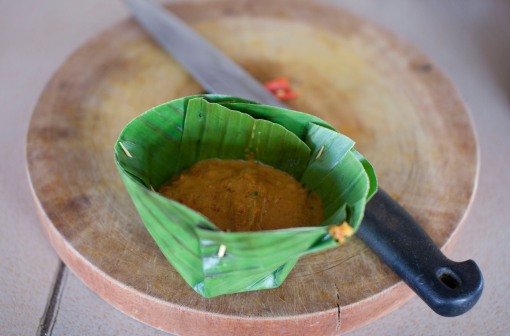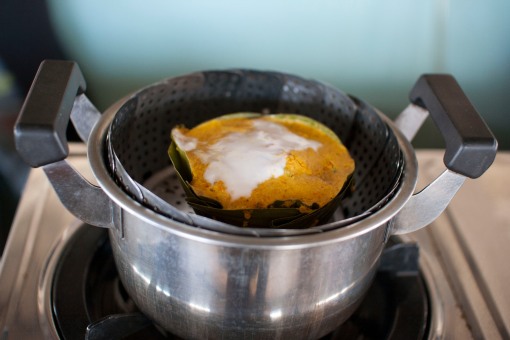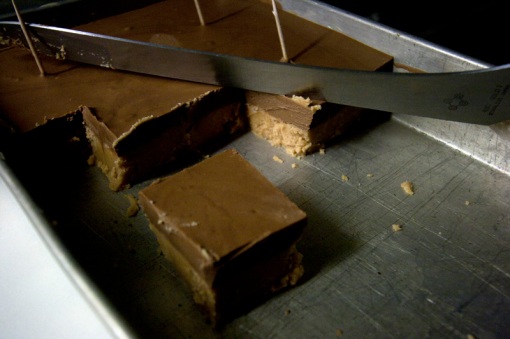Fish Amok
 On Monday I decided to attend a Cambodian cooking class. This is something I’ve been wanting to do for some time… since December 2009, actually, when a friend first suggested it. The class took place at a property owned by the restaurant Frizz on Street 240.
On Monday I decided to attend a Cambodian cooking class. This is something I’ve been wanting to do for some time… since December 2009, actually, when a friend first suggested it. The class took place at a property owned by the restaurant Frizz on Street 240.
We kicked off the day at 9am for a quick tour of common Cambodian cooking ingredients at one of the better vegetable markets in town, Kandal market. It’s a place that I’ve been to a number of times, so it wasn’t really that exciting for me, but the class is geared toward tourists and not… locals, so I didn’t complain.
Our class was lead by a young guy named Heng (or was it Keng?) who had actually gone through the horeca training program at Friends International. He was a pretty vibrant guy who spoke English relatively well, and knew a fair bit about the culinary history of Cambodia.
After our market tour with Heng, we headed back to our kitchen, an open-air facility on the second floor of a building behind the restaurant. The first thing on the menu was Cambodian spring rolls (chaio yor).
Now, I’ve been particularly curious about Cambodian spring rolls, because I asked our former maid to make some for us when I first arrived in Cambodia this summer, and she weaseled her way out of it twice, claiming that they were very difficult to make. By the end of this class however, I determined that the maid was definitely not made a former maid in error. Cambodian spring rolls are super easy.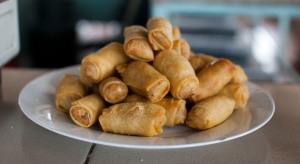
Basically, it involves two cups of grated taro root (coco yam) and 2 cups of grated carrot. The most involved step is taking the starch out of the taro, which is easily done by sprinkling about a tablespoon of salt onto the yam and gently squeezing and working the yam for about 3-5 minutes until the moisture is drawn out of the yam.
Next, we spiced the spring roll filling with some sugar and ground black pepper and about a tablespoon of ground peanut.
The next step was to roll the spring rolls… very straightforward, we just used a beaten egg to seal the rolls, and took care to make them as tight as possible, so as to keep them from soaking up too much oil when they are fried.
After that, we fried the spring rolls in about 3 cups of cooking oil inside of a wok, until they were golden brown.
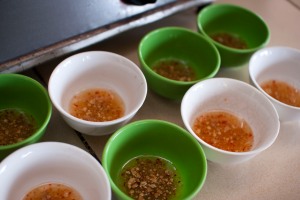 As for the dipping sauce, it’s just a variation of nuoc cham, with the very same ingredients, so see my previous entry for details.
As for the dipping sauce, it’s just a variation of nuoc cham, with the very same ingredients, so see my previous entry for details.
The next thing on the menu was the fish amok. While there is a great overlap between Cambodian, Thai and Vietnamese food, fish amok is one of those dishes that is very, very Cambodian. It’s a quick favourite among visitors and expats alike, because of the sweet taste of the coconut milk and cream in the amok.
Oddly enough, the recipe featured in the cookbook we were given is different from the recipe we used in the class, so I’m going off the top of my head for some of the quantities. In any case, here goes: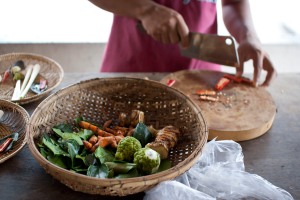
Kroeung (herb paste)
-10 dried red chilies (the non spicy, larger variety) soaked, drained and chopped into a paste.
-4 cloves garlic
-3 tbsp of galangal (cut small) … if you can’t find galangal, use ginger root
– 8 thinly sliced lemongrass stalks (outer leaves and lower part of bulb removed–chop starting at the bulb end, and chop about one-third of the length of the stalks, and discard the rest)
-zest of 1/3 kaffir lime
-1 tsp salt
-2 tbsp of chopped fresh turmeric
-1 to 3 sliced bird’s eye chilies, depending on how much heat you want
-1 small shallot
Directions:
Combine all the ingredients in a food processor (or mortar) and blend to a thick paste.
Amok – Serves 4
-kroeung
–3 tbsp fish sauce
-3 tbsp kaffir lime leaves
-3 chili peppers
-500g snakehead fish (trei ros), or any meaty white fish…
-2 cups coconut milk
-3/4 cup coconut cream
-1 egg, beaten
-8 banana leaves (might be smart to buy extras, especially the first time)
Making the banana cup:
First, clean the leaves with a wet cloth, then dip them into boiling water so they are soft and do not crack when being shaped.
Cut the leaves into circles about 25cm in diameter and place two together, with the shiny sides facing outward.
Make a square in the middle of the circle, this will be the bottom of the cup.
Then, put a thumb on one right angle of the square and pull up two sides, tucking the fold, and pinning together with a tiny bamboo stick, toothpick, or stapler.
Repeat this four times, so that the cup has five equally spaced folds.
The rest of the amok:
Slice the fish thinly and set aside. Stir the kroeung into 1 cup of coconut milk. When it has dissolved, add the egg, fish sauce and sliced fish. Then add the remaining coconut milk and mix well.
Divide the mixture evenly among the four banana leaf cups and steam for 15-20 minutes, then put the coconut cream on top, as well as the kaffir leaves (thinly sliced) and thinly sliced sweet chili pepper for garnish. Steam further until the mixture is solid, but still moist.
Serve with rice, and enjoy!!
